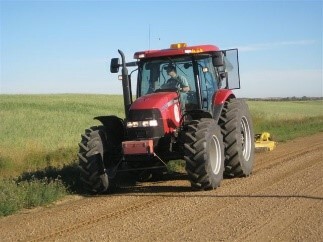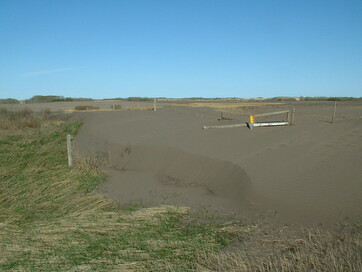Planting Trees in Dry Conditions
Agriculture and Agri-Food Canada
Although trees enhance snow capture and moisture retention through slower melt and reduced evaporation rates, drought conditions make establishing trees more challenging. It can be very difficult to care for and maintain trees during times of normal moisture, but when conditions are dry, it is all the more crucial that adequate planning and preparations are made.
Before you design and plant your shelterbelt, ask yourself the following questions:
- Is there adequate soil moisture?
- What type of soils do I have?
- What soil moisture conserving techniques such as mulch can be used?
- Do I have a secure and dependable water source for watering or to run a trickle irrigation system?
Water is the most limiting factor for tree survival and growth during drought conditions. Trees use water during photosynthesis and lose water during transpiration. Water shortages effect newly planted trees as well as established trees. Prolonged drought conditions can lead to tree decline, increased mortality, shorter life span, and can make trees more susceptible to pest problems. Supplementary watering should be part of a tree maintenance plan, especially during hot windy periods in summer and just before freeze-up, to reduce desiccation and mortality during the winter.
The best time to water is early in the morning, during the evening hours, or at night. During these hours, trees have a chance to replenish their moisture when they are not stressed by hot temperatures and this also allows for the most effective use of water with less evaporative losses. The best way to water is gradually with a soaker hose or by trickle or drip irrigation. Consider using an organic (e.g. straw, woodchips) or plastic mulch to conserve moisture and reduce losses. Mulches can be used in conjunction with irrigation systems.
Recently planted trees require more watering than established plantings. For larger trees, watering should take place below the crown and extending a few feet beyond the drip line of the branches which is generally the area under the tree shaded by the foliage. The amount of water depends upon the soil type, tree species, temperatures, and the amount and timing of previous precipitation. Trees planted in soils that are sandy textured, low in organic matter or on slopes will require more water. Trees in heavy texture soils (e.g. clay) with greater water-holding capacity require less water.
Newly planted trees should be watered once a week in the growing season if there is limited rainfall. Supplemental watering may be needed in established plantings during prolonged droughts, especially in soils with poor water holding capacity. A few good deep waterings are more beneficial than many light, shallow waterings. Light waterings encourage shallow rooting that can result in greater damage during lengthy droughts.
Greater water volume and deeper watering at less frequent intervals is recommended for healthy tree roots. Note: Check the quality of your water (well or dugout) before applying to trees as poor quality water (i.e. high in salts) can negatively impact tree growth. Problems can also occur if water with a conductivity rating of > 750 micromhos/cm is used to water trees.
Adequate site preparation and controlling weed competition is extremely critical during the first three years after planting. New plantings require maintenance for survival and optimum growth. Competing vegetation reduces water and nutrient availability, space and light thereby limiting plant growth and increasing the time required to reach your desired goals.
Site preparation one year before planting is recommended for successful tree establishment and growth. Perennial weeds and grasses are much more difficult to control after the trees and shrubs have been planted. Focusing on removing perennial weeds before planting allows for the use of a wider range of tillage and herbicide control options.
The soil should be prepared to a garden tilth and to a depth of 15 to 20 cm (6 to 8 in.) in the year prior to planting. Stake the rows before planting. Proper site preparation is extremely important if you are planning to apply mulch to the site.
If planning on installing plastic mulch, prepare the planting strip to a width of 2.5 m (8 ft.); otherwise the worked strip only needs to be 1.2 m (4ft.) wide. Plastic mulch is a very effective method to control weeds within the tree row and to reduce soil moisture loss from surface evaporation and weed competition. Use of either organic or inorganic mulches will greatly improve plant survival in drought conditions. However, during extended dry periods, all tree species may require supplemental watering regardless of whether mulch has been used or not.
Eliminate weed competition, water regularly, and protect trees from damage by wildlife and livestock. Good maintenance will positively influence tree survival and performance. Weed control methods include mulching, mechanical cultivation, hand hoeing and herbicide application. For more information on weed control, please refer to the AAFC publication “Controlling Weeds in Your Agroforestry Planting.” Note: Within the tree planting, till the soil to a depth no greater than 10 cm (3 to 4 in). Deep tillage will damage roots leaving the tree susceptible to drought and pests.
Fertilizing is not necessary and is not recommended for newly planted shelterbelts. For farmyard shelterbelts planted adjacent to lawns, avoid using fertilizers on the lawn with weed-killing additives, such as dicamba, that may damage the trees. Use extreme care when applying herbicides on cropland next to shelterbelts to avoid drift damage to the trees.
Planning and Design
Tree Pests
Insects are one of the largest divisions of the animal kingdom. Though most species of insect do not cause harm to trees. It is important to be able to recognize which kinds of insects are causing problems in order to choose the appropriate control measures to mitigate further damage.
Insect Pests
Aspen Leafroller
This year like in in the previous year there is many poplars being affected by the aspen leafroller. They roll themselves in leaves for protection and to pupate. The caterpillar is green with a brown or black head and is about 3/4” to inch long. Damage to the trees is temporary and will not kill the trees. To control them you need to spray a dormant oil in the early spring as the leaf protects them from spraying.
Poplar Borer
Signs of this insect are large holes with sawdust or shredded wood coming out of the holes and piled at the base of the trunk. Sap leaks down and stains the bark brown attracting other insects. The insect prefers trees with a diameter of about 4”, in low density stands. The insect has a long life cycle, extending over 3 to 4 years.
Yellow-headed Spruce Sawfly
Produces a green larva with a prominent yellow or amber coloured head and thin grey stripes running the length of the body. An insecticide application is generally the most effective method of control.
Spruce Budworm
Majority of the feeding is done by mid-to-late June. The mature larvae are about ¾” to an inch long, with a black head and a reddish brown body that is lighter on the sides and has two rows of whitish spots on the back. Pupation occurs at feeding sites or on the lower branches. The moths emerge in late June to early August and lay their eggs in masses (15-50 eggs) on the underside of the needles in mid-to-upper crown and then hatch in about 10 days.
Other Insects
Tree Diseases
Black Knot - Black Knot is a very common disease of plants in the genus Prunus (plums, cherries, etc.). The most distinguishing symptom of Black Knot is the characteristic black, tar-like swellings that develop on branches of the infected plant. This disease reduces the aesthetic value of affected specimens, as infections spread rapidly; high levels may result in the eventual death of the plant.
Needle Cast - On Colorado blue spruce, infected needles often show symptoms of yellow mottling in mid-to-late summer. Needles progressively turn bright yellow, purplish-pink and finally brown. Cool, rainy weather or long periods of needle wetness provide conditions for disease development. Branches that lose first-year needles for 3 to 4 consecutive years may die.
Poplar Leaf Spot - Leaf spot spores are released in spring and early summer from fruiting bodies that overwintered on fallen leaves or infected shoots. These spread by wind and rain to newly emerging leaves or young shoots. In summer and fall, spores produced on leaf and stem lesions spread to other plants and cause secondary infections. Repeated outbreaks can cause branch dieback and make trees susceptible to infection by other pathogens or pests.
Fireblight - Is a highly destructive disease of several members of the rose family. It is native to North America and in Alberta, this disease can affect many highly desirable hardy ornamentals and fruit-producing species in the rose family including apple, crabapple, cotoneaster, hawthorn, pear, mountain ash, raspberry, saskatoon berry, plum and cherry. It is particularly destructive to species that are not native to Canada such as crabapple, apple and pear.
Bronze Leaf - It infects various poplar species and hybrids; specifically, trembling aspen, Swedish columnar aspen and tower poplar. Symptoms typically appear in midsummer. Spores are dispersed from April-June when rainfall is present and temperatures are around 18 C. Once infected, the fungus moves systemically within the leaf's vascular system, making it difficult to control.
Mammal & Bird Pests
Other Resources
Browning of Evergreens
Pests of Deciduous Trees and Shrubs
Pests of Coniferous Trees and Shrubs
Aspen Defoliators
Pests of Small Fruit
Agroforestry Diseases and Pests



